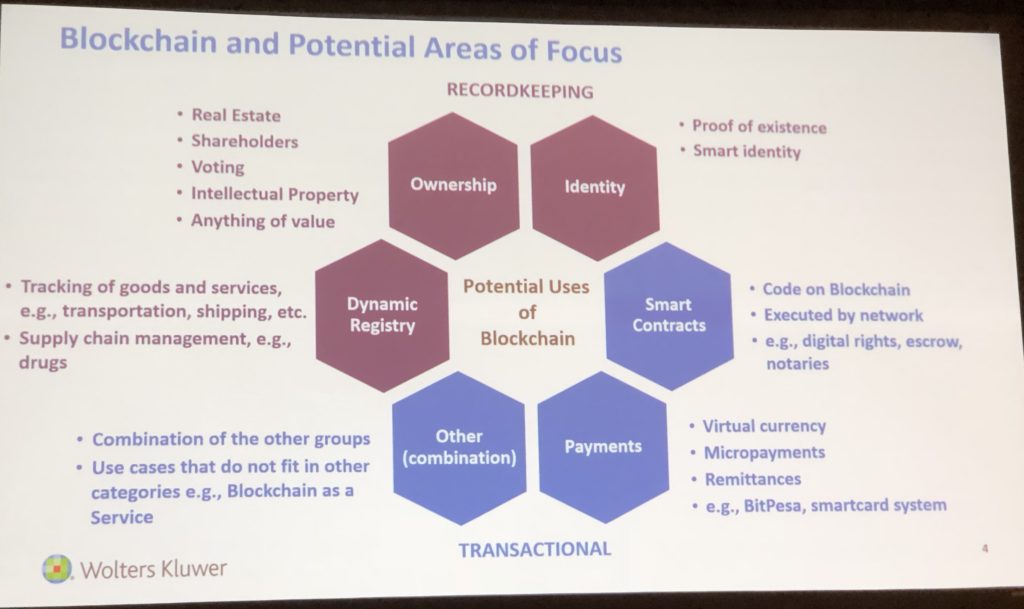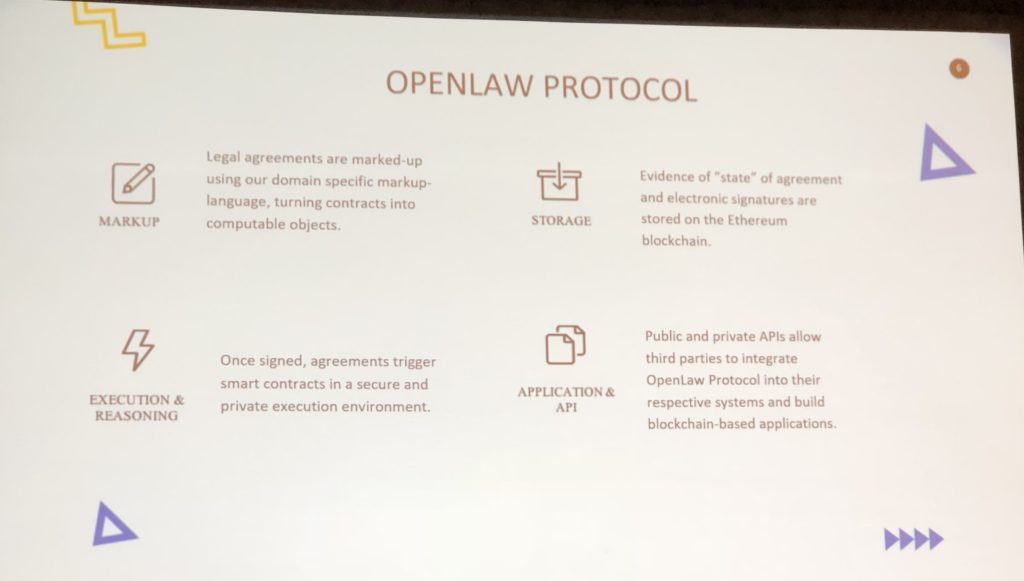I am attending How to Integrate Blockchain Technology into Existing Legal Software, hosted by the Global Legal Blockchain Consortium at its GLBC Annual Meeting, at the International Legal Technology Association annual conference, ILTACON 2018. This is live – I post as soon as the session ends – so please forgive any typos or misunderstanding of meanings.
This is the afternoon session – demos by and presentation from Consortium members. It runs from 12:30 to about 3:30 and there are no breaks. My degree of note taking here depended on the topic (denoted with sub-headings). Some presented on actual demo use cases; other just talked about aspirations.
Wolters Kluwer Legal & Regulatory and Blockchain
Nita Sanger, Head of Global Innovation and Tina Welu, Senior Innovation Manager presenting.
Blockchain is a single source of truth. It provides transparency, accountable in a secure and efficient system. It drives productivity. Looking at record keeping and transactions. In former, the goal is proof of ownership, proof of existence, and identity.

B
But use in production is not going to happen soon. Issues include privacy, especially under GDPR and EU right to be forgotten. Also, who owns the content on ownership. Whose law applies across jurisdictions. Also, need a standards setting process.
Applications at WK will be driven by customer need. Looking at secure doc exchange, veracity of e-courts and e-justice filing, immutable health records, filling invoices. and more.
Look at WK product effacts, which is legal management software for law departments (ELM). WK lookin at proof of concept for e-signing an NDA. Video shows this. It shows sending an NDA and recipient can look at the blockchain hash and verify it is correct. As I understand it, this use case is all about verification and attaching an e-signature. My commentary: the functionality here looks similar to DocuSign. If that’s the case, then I’d want to know which option – DocuSign, blockchain, or other signing solution – was lower cost and easier to use.
I want to ask how this differs from DocuSign or other commercial product but no time for Qs.
Service of Process on Blockchain by ServeManager
ServeManager is a product that supports service of process. Atr launch 5 years ago, problem to solve was tracking status of service papers: attempts, proof, tracking, notes, affidavit, verification. In NYC, 66% of cases had “sewer service” (papers thrown in sewer).

Shows mobile US for tracking the service, including attempts. Mobile captures geo location, time, and uploads to Integra, which provides a blockchain verification, to generate an accountability report.
What this allows is tracking all service attempts and court to verify proper service.
Ron comment: This strikes me as a good use case given the challenges of service of process. It may not 100% provide absolute proof of service but I think that the tracking gets us closer to where we should be for proof. The question I have is why we need blockchain for this. Sure, blockchain provides a form of third party proof. But could the company’s own databases do this and wold courts rely on that?
The White Company
Uses blockchain for global payments. Claim is faster and more secure payment process. Four solutions: stable coin (cryptocurrency pegged to real world currency), cyrptocurrency payment solution (C2C, C2B, and B2B), cryptocurrency reloadable debit card, and luxury marketplace. Converted over $100M US to cryptocurrency, >25k customers. Some days achieve $200k in exchange.
The problem today is low cost, fast, and reliable payments.

With other cryptocurrencies, value changes to quickly, making those solutions impractical for real world goods. Once monthly, there is an audit process to confirm company has the cryptocurrency it says it has. This shows clients stablility and safety.
NetDocuments
Shows a profile of a “pure digital transaction.” First step is to start an agreement in NetDocuments (ND). Today, we’d attach the document to email, get back the executed agreement. With blockchain, user can lock the document and connect it to the blockchain. This will create a verified (via hash) version of the document on the blockchain. In the future, users can verify that original document via query to blockchain:

To enable this in production, we need standards + governance, APIs + permissioned blockchain, and blockchain storage.
Another ND example is profile of attachment encryption. The issue today is challenge of cross organization encryption. Use the blockchain to exchange keys to facilitate encrypted email is the use case.
Store the public key on the blockchain. When sending an email, user has option to encrypt attachment with the public key associated with the email address on the blockchain. Recipient uses locally stored private key to decrypt the message.
Legaler
Caption of presentation is “The Blockchain Infrastructure for the Future of Legal Services”.
Describes access problem: 2B people have no access to banking. 3.5B have not Internet access. 4B people have not access to justice (UN stat). 80% of US population cannot access legal help.
Can blockchain help solve the access to justice (A2J) problem? Developed economies today are structured around trusted intermediaries. The blockchain – with its distributed trust, eliminates the need for trusted intermediaries (says the speaker).
Legaler says it will solve with a combination of tools:

Says it will be scalable, secure, economical, and private. Built on Ethereum.
On top of above, Legaler is building protocols: identity, communication, transaction, payment, and disputes. Problems this will solve including “fake lawyers” (several headlines of reported such problems is shown). Legaler will provide global identity / verification that a person is a lawyer. Working with law schools and employers to prove lawyer. Also setting up a self-sustaining legal charity and crowdfunding legal help.
Ron comments:
- DAO is distributed autonomous organization. After the collapse of the Ethereum DAO and loss of millions / hard fork in blockchain to reverse, I get nervous at mention of DAO.
- Funding for and connecting clients to lawyers will help with A2J but I’m not seeing a big solution here. It’s possible I missed something key in this presentation.
OpenLaw
OpenLaw is creating a blockchain to transfer assets in a legally enforceable way. Smart contracts have limitations in code and are hard to write. OpenLaw is building tools for peer-to-peer drafting on the blockchain.

It’s a network approach with public and private instances. A canned demo shows how to transfer property on this solution.
Thomson Reuters –
Automated contract drafting and document verification with Integra Ledger, on top of TR ContractExpress.
TR commitments include: A priority is to identify document exchange where use cases where trust issues exist. Collaborate with other players for standards for a permissioned blockchain for legal documents. ID where TR solutions can be integrated with Integra Ledger.
TR is integrating data inputs used to form contracts in ContractExpress (document automation software) in the blockchain, with the ability to track future payments against that contract.

There is a video to explain how this works (hard to capture that).
TR is working with NetDocuments to integrate Contract Express into it and Integrea, especially to avoid over-hashing.
Association of Legal Administrators (ALA)
James Cornell, III, president-elect of ALA, presents.
No prototype, instead explanation of power of consortia. ALA is involved in other consortia in addition to Integra.
LegalBeagles
Global access to justice = community + AI + Blockchain
LegalBeagles, founded in 2007, is the largest free forum offering discussion and advice for legal issues. It reaches 1.5 consumers annually, has 111k registered members, there are 800k impartial Q&A posts in the forum, and 150 volunteers for peer reviewed advice.
Users today ask questions on forum and volunteers answer questions. Started a commercial journey four years to ensure long term survival of LegalBeagles. First commercial venture was to start an Avvo-like service in UK.
Saw the potential to analyze the data in the forum. Working with IBM on a mobile app, machine learning of the forum data, AI-driven responses, guided support, blockchain, and data network effect.
Goal is to build a Beagle Wallet for identity verification and secure storage of key personal documents such as wills and powers of attorney. See diagram below for additional goals:

Integra Announces a Second Blockchain
Integra sponsored the Global Legal Hackathon earlier in 2018. About 30% of hundreds of projects involved blockchain. Says this gives us a sense of what’s coming.
Announcement today: adding a 2nd blockchain. Integra is platform neutral. It is the Microsoft Ethereum Proof-of-Authority blockchain. Issue is the Ethereum public network does not work for most legal applications. Microsoft proof-of-authority, hosted on Azure, addresses that issue. Proof-of-authority approach is about one year old. It establishes trust, speeds up the blockchain network.
The Integra API allows accessing both HyperLedger and the Microsoft Ethereum proof-of-authority blockchain.
IBM Watson – Brian Kuhn – Future of AI and Intersection with Blockchain
The intersection of AI and blockchain “will revolutionize legal”.
Outlines the challenge of law firms differentiating their services and points out that law firms are losing business to their clients and alternate providers. Asks how law firms can re-capture lost revenue and suggests that AI will help lawyers do this. The AI will reflect firm-specific reasoning for the most repeatable categories of legal work and licensed by firms to their clients. His key points illustrated in next two slides:


Only blockchain can enable AI with provenance assurances: This goes to confirming who trained the AI. Are the data used in training copyrighted, “fake”, or contextually irrelevant. Can clients protect themselves from liability showing provenance of machine learning decision making.

Archives
Blog Categories
- Alternative Legal Provider (44)
- Artificial Intelligence (AI) (57)
- Bar Regulation (13)
- Best Practices (39)
- Big Data and Data Science (14)
- Blockchain (10)
- Bloomberg Biz of Law Summit – Live (6)
- Business Intelligence (21)
- Contract Management (21)
- Cool Legal Conferences (13)
- COVID-19 (11)
- Design (5)
- Do Less Law (40)
- eDiscovery and Litigation Support (165)
- Experience Management (12)
- Extranets (11)
- General (194)
- Innovation and Change Management (188)
- Interesting Technology (105)
- Knowledge Management (229)
- Law Department Management (20)
- Law Departments / Client Service (120)
- Law Factory v. Bet the Farm (30)
- Law Firm Service Delivery (128)
- Law Firm Staffing (27)
- Law Libraries (6)
- Legal market survey featured (6)
- Legal Process Improvement (27)
- Legal Project Management (26)
- Legal Secretaries – Their Future (17)
- Legal Tech Start-Ups (18)
- Litigation Finance (5)
- Low Cost Law Firm Centers (22)
- Management and Technology (179)
- Notices re this Blog (10)
- Online Legal Services (64)
- Outsourcing (141)
- Personal Productivity (40)
- Roundup (58)
- Structure of Legal Business (2)
- Supplier News (13)
- Visual Intelligence (14)

